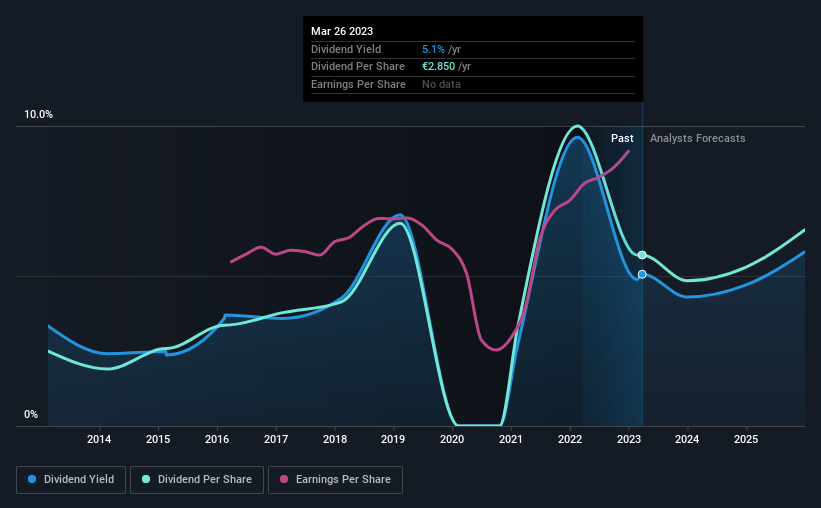Be Sure To Check Out Randstad N.V. (AMS:RAND) Before It Goes Ex-Dividend
Randstad N.V. (AMS:RAND) is about to trade ex-dividend in the next 3 days. The ex-dividend date occurs one day before the record date which is the day on which shareholders need to be on the company's books in order to receive a dividend. The ex-dividend date is an important date to be aware of as any purchase of the stock made on or after this date might mean a late settlement that doesn't show on the record date. In other words, investors can purchase Randstad's shares before the 30th of March in order to be eligible for the dividend, which will be paid on the 4th of April.
The company's next dividend payment will be €2.85 per share, on the back of last year when the company paid a total of €2.85 to shareholders. Based on the last year's worth of payments, Randstad stock has a trailing yield of around 5.1% on the current share price of €56.34. Dividends are an important source of income to many shareholders, but the health of the business is crucial to maintaining those dividends. As a result, readers should always check whether Randstad has been able to grow its dividends, or if the dividend might be cut.
Check out our latest analysis for Randstad
Dividends are typically paid out of company income, so if a company pays out more than it earned, its dividend is usually at a higher risk of being cut. Randstad is paying out an acceptable 57% of its profit, a common payout level among most companies. A useful secondary check can be to evaluate whether Randstad generated enough free cash flow to afford its dividend. Thankfully its dividend payments took up just 43% of the free cash flow it generated, which is a comfortable payout ratio.
It's positive to see that Randstad's dividend is covered by both profits and cash flow, since this is generally a sign that the dividend is sustainable, and a lower payout ratio usually suggests a greater margin of safety before the dividend gets cut.
Click here to see the company's payout ratio, plus analyst estimates of its future dividends.
Have Earnings And Dividends Been Growing?
Stocks in companies that generate sustainable earnings growth often make the best dividend prospects, as it is easier to lift the dividend when earnings are rising. Investors love dividends, so if earnings fall and the dividend is reduced, expect a stock to be sold off heavily at the same time. With that in mind, we're encouraged by the steady growth at Randstad, with earnings per share up 8.3% on average over the last five years. Decent historical earnings per share growth suggests Randstad has been effectively growing value for shareholders. However, it's now paying out more than half its earnings as dividends. If management lifts the payout ratio further, we'd take this as a tacit signal that the company's growth prospects are slowing.
The main way most investors will assess a company's dividend prospects is by checking the historical rate of dividend growth. Randstad has delivered an average of 8.6% per year annual increase in its dividend, based on the past 10 years of dividend payments. We're glad to see dividends rising alongside earnings over a number of years, which may be a sign the company intends to share the growth with shareholders.
The Bottom Line
Has Randstad got what it takes to maintain its dividend payments? Earnings per share growth has been modest and Randstad paid out over half of its profits and less than half of its free cash flow, although both payout ratios are within normal limits. All things considered, we are not particularly enthused about Randstad from a dividend perspective.
With that in mind, a critical part of thorough stock research is being aware of any risks that stock currently faces. To help with this, we've discovered 2 warning signs for Randstad (1 is potentially serious!) that you ought to be aware of before buying the shares.
Generally, we wouldn't recommend just buying the first dividend stock you see. Here's a curated list of interesting stocks that are strong dividend payers.
Have feedback on this article? Concerned about the content? Get in touch with us directly. Alternatively, email editorial-team (at) simplywallst.com.
This article by Simply Wall St is general in nature. We provide commentary based on historical data and analyst forecasts only using an unbiased methodology and our articles are not intended to be financial advice. It does not constitute a recommendation to buy or sell any stock, and does not take account of your objectives, or your financial situation. We aim to bring you long-term focused analysis driven by fundamental data. Note that our analysis may not factor in the latest price-sensitive company announcements or qualitative material. Simply Wall St has no position in any stocks mentioned.
Join A Paid User Research Session
You’ll receive a US$30 Amazon Gift card for 1 hour of your time while helping us build better investing tools for the individual investors like yourself. Sign up here

